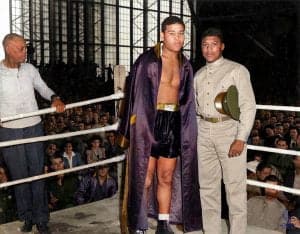Thank you to Nathan Howland @HowdiColourWorks for sharing these amazing colorized photos of the Tuskegee Airmen!
A very rare historical shot of Joe Louis ‘The Brown Bomber’, his coach (ex-boxing champion) Jack Blackburn, corner-man Mannie Seamon, and a, ‘unknown’ Tuskegee Airman, merely notated on the back of the photograph as ‘Tiny’.
I have had three images from this day in my possession for a number of years now, and no manner of research seems to shed any light on the proud Tuskegee, and the specific venue in question.
What is know is that S/Sgt Barrow AKA Joe Louis Barrow fought approximately 100 exhibition fights during his time in the U.S. Army, and raised literally hundreds of thousands of dollars in denotations from prize fights, the winnings from which being donated to establishment such as the Navy Relief Fund, and the Army Services Relief Fund.
To this end, Louis was given the role of Goodwill Ambassador. The Army formed a travelling group of black boxers (one can be seen in the crown close to the right bottom right) which toured the United States and Europe. If he had an issue with an all-black boxing group, Louis never spoke about it. He did, however, refuse to box in front of segregated audiences.
The touring show was a hit—a mix of boxing and singing and dancing (courtesy of another boxer one Sugar Ray Robinson!). In 1943, the tour spent 100 days on the road in the United States. By 1944 Louis was in Europe, entertaining troops and shaking the hands of wounded men from the Normandy campaign. In his book, Joe Louis, Randy Roberts explained the impact of Louis’ visits upon the troops, quoting one GI who watched Louis perform and later wrote: “No movie star has been greeted by our fighting men with more enthusiasm than that displayed when the Brown Bomber got into action.” When he visited the wounded troops, one GI whose eyes had been seriously hurt in the fighting asked the nurse to remove his bandages. ”Let me have just one look at him,” he pleaded. ”I’ll take my chance with my eyesight.”
Behind the scenes, Louis used the information gathered from talking to black troops to encourage positive changes. He even stepped in to help future baseball star Jackie Robinson when Robinson knocked out a white officer’s front teeth. Robinson had stood up to the officer after he made racist remarks. Louis was able to intervene, keeping Robinson from being court-martialed or worse, and Robinson was allowed to continue Officer Candidate School. It was just another example of how Louis was considered a “saviour of African Americans” during the war. He had the respect to stand up for his fellow man, and the influence to make a difference. Louis’ way of helping was in line with his personality. There were no loud speeches, no public displays, and no letters written. He would simply step in, ask a favour, or make the request himself. Louis is credited with helping to desegregate army buses, quietly, and successfully.
Despite his reserved personality, Louis appeared in several films during the war, including Irving Berlin’s This is the Army and The Negro Soldier. Made with the hope of soothing growing racial tensions in the United States, Louis was a central feature in the latter film. Highlighting his fight with Max Schmeling in 1938, it played up the war as a continuation of the fight between the two. Produced by Frank Capra, ‘The Negro Soldier’ portrayed African Americans in a way rarely seen at the time, as patriotic and thoughtful and with more personal depth than most contemporary portrayals of African Americans. An army film, it challenged segregation in the army and in America. Louis was once again a champion for his people, and his country!
Photo: Authors Private Collection.
Image Repair & Colourisation – Nathan Howland @HowdiColourWorks.


